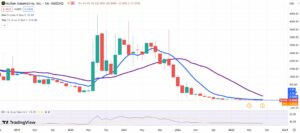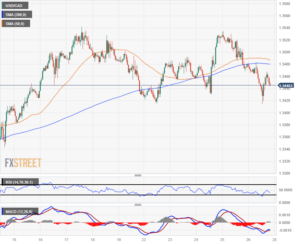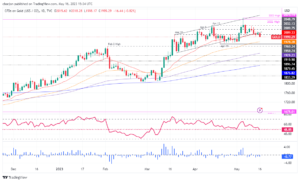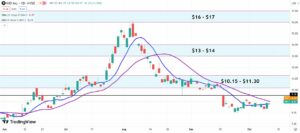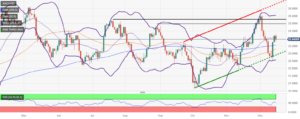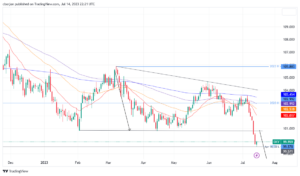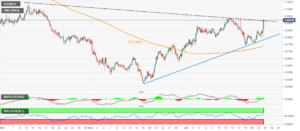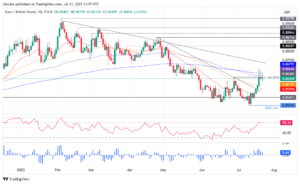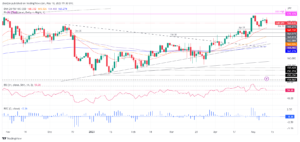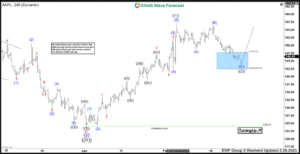
- The Japanese Yen continues with its relative outperformance amid hawkish BoJ expectations.
- Bets for a series of rate cuts by the Fed in 2024 undermines the USD and weighs on USD/JPY.
- Bears turn cautious and look to the US PCE Price Index for a fresh impetus later this Thursday.
The Japanese Yen (JPY) remains on the front foot against its American counterpart for the fifth successive day on Thursday amid expectations that the Bank of Japan (BoJ) will soon end its negative rate policy. The JPY bulls, meanwhile, largely shrugged off Wednesday’s less hawkish remarks by BoJ board member Seiji Adachi, saying that the economy is yet to reach a stage where the central bank could debate an exit from ultra-easy monetary policy. On the economic data front, Japanese Retail Trade for October missed consensus estimates, though the disappointment was offset by an upward revision of the previous month’s reading and better-than-expected Industrial Production figures.
The US Dollar (USD), on the other hand, struggles to capitalize on the overnight recovery from its lowest level since August 11 amid dovish Federal Reserve (Fed) expectations and keeps the USD/JPY pair depressed near a three-month low. Investors are now convinced that the US central bank is done raising interest rates and may begin easing its monetary policy as early as March 2024. Moreover, the markets are now pricing in a cumulative 100 bps of rate cuts by the Fed in 2024, which overshadows the upbeat US GDP report released on Wednesday, showing that the economy grew at a faster pace than estimated originally during the third quarter, continues to undermine the Greenback.
The aforementioned fundamental backdrop suggests that the path of least resistance for the USD/JPY pair is to the downside. Bearish traders, however, seem reluctant to place aggressive bets ahead of the US PCE Price Index, due for release later during the early North American session. The core gauge is the Fed’s preferred benchmark for measuring longer-term inflation trends and might influence the next policy move. This, in turn, should provide some meaningful impetus to the buck and determine the near-term trajectory for the USD/JPY pair ahead of Fed Chair Jerome Powell’s speech on Friday.
Daily Digest Market Movers: Japanese Yen sits near multi-month peak against the USD ahead of US PCE data
- The Japanese Yen draws support from hawkish Bank of Japan expectations even though board member Seiji Adachi on Wednesday downplayed speculations about an imminent shift in the policy stance.
- BoJ’s Adachi says that Japan is yet to see a positive wage-inflation cycle become embedded enough and it is appropriate to patiently maintain the current easy policy.
- Adachi added that BoJ will take additional easing steps if needed and the move in October to make YCC flexible was not aimed at laying the groundwork for policy normalisation.
- Japanese Retail Trade fell 1.6% in October but grew by 4.2% from a year earlier. The previous month’s reading was revised higher to show a rise of 6.2% against 5.8% reported.
- Japanese Industrial Production rose more than expected, by 1% in October, as compared to the previous month’s 0.5% uptick and increased 0.9% compared with a year earlier.
- The second estimate of the US GDP showed that the world’s largest economy grew by a 5.2% annualized pace during the third quarter as compared to the 4.9% reported previously.
- The upbeat US macro data, however, was largely offset by more dovish comments by Federal Reserve officials, which reaffirmed bets for a series of rate cuts in 2024.
- Cleveland Fed President Loretta Mester saw clear progress in getting inflation to 2% and said that monetary policy must be nimble in current circumstances.
- Separately, Richmond Fed President Tom Barkin believes that inflation will be more stubborn than what they would like and is unwilling to take another interest rate hike off the table.
- US rates futures markets are now pricing in more than 100 bps of rate cuts next year, starting in May, and the yield on the rate-sensitive two-year US government bond is at its lowest since July.
- This keeps the US Dollar bulls on the defensive and exerts some pressure on the USD/JPY pair for the fifth straight day, ahead of the release of the US PCE Price Index later this Thursday.
Technical Analysis: USD/JPY bulls are trying hard to defend the 100-day SMA pivotal support
From a technical perspective, the USD/JPY pair, so far, has been showing some resilience below the 100-day Simple Moving Average (SMA), warranting caution for bearish traders. That said, oscillators on the daily chart are holding deep in negative territory but still some distance away from being oversold. This, in turn, suggests that the path of least resistance for spot prices remains to the downside and any meaningful recovery attempt could be seen as a selling opportunity.
Meanwhile, the multi-month trough, around the 146.65 region touched on Wednesday, now seems to protect the immediate downside, below which the USD/JPY pair could accelerate the fall towards the 146.00 round figure. On the flip side, the 147.30-147.35 zone is likely to act as an immediate hurdle ahead of the overnight swing high, around the 147.90 area and the 148.00 mark. Any further move up could attract fresh sellers and remain capped near the 148.30 strong horizontal support breakpoint, now turned resistance.
Japanese Yen price today
The table below shows the percentage change of Japanese Yen (JPY) against listed major currencies today. Japanese Yen was the strongest against the Canadian Dollar.
| USD | EUR | GBP | CAD | AUD | JPY | NZD | CHF | |
| USD | -0.03% | 0.00% | 0.00% | -0.03% | -0.03% | -0.19% | -0.10% | |
| EUR | 0.04% | 0.03% | 0.03% | 0.00% | 0.01% | -0.16% | -0.09% | |
| GBP | 0.00% | -0.03% | 0.01% | -0.02% | -0.02% | -0.18% | -0.09% | |
| CAD | 0.00% | -0.04% | -0.01% | -0.03% | -0.02% | -0.19% | -0.10% | |
| AUD | 0.00% | 0.00% | 0.02% | 0.03% | 0.05% | -0.17% | -0.09% | |
| JPY | 0.00% | 0.00% | 0.02% | 0.03% | -0.05% | -0.14% | -0.08% | |
| NZD | 0.19% | 0.16% | 0.19% | 0.18% | 0.16% | 0.16% | 0.10% | |
| CHF | 0.10% | 0.06% | 0.09% | 0.08% | 0.07% | 0.06% | -0.11% |
The heat map shows percentage changes of major currencies against each other. The base currency is picked from the left column, while the quote currency is picked from the top row. For example, if you pick the Euro from the left column and move along the horizontal line to the Japanese Yen, the percentage change displayed in the box will represent EUR (base)/JPY (quote).
Bank of Japan FAQs
The Bank of Japan (BoJ) is the Japanese central bank, which sets monetary policy in the country. Its mandate is to issue banknotes and carry out currency and monetary control to ensure price stability, which means an inflation target of around 2%.
The Bank of Japan has embarked in an ultra-loose monetary policy since 2013 in order to stimulate the economy and fuel inflation amid a low-inflationary environment. The bank’s policy is based on Quantitative and Qualitative Easing (QQE), or printing notes to buy assets such as government or corporate bonds to provide liquidity. In 2016, the bank doubled down on its strategy and further loosened policy by first introducing negative interest rates and then directly controlling the yield of its 10-year government bonds.
The Bank’s massive stimulus has caused the Yen to depreciate against its main currency peers. This process has exacerbated more recently due to an increasing policy divergence between the Bank of Japan and other main central banks, which have opted to increase interest rates sharply to fight decades-high levels of inflation. The BoJ’s policy of holding down rates has led to a widening differential with other currencies, dragging down the value of the Yen.
A weaker Yen and the spike in global energy prices have led to an increase in Japanese inflation, which has exceeded the BoJ’s 2% target. Still, the Bank judges that the sustainable and stable achievement of the 2% target has not yet come in sight, so any sudden change in the current policy looks unlikely.
- SEO Powered Content & PR Distribution. Get Amplified Today.
- PlatoData.Network Vertical Generative Ai. Empower Yourself. Access Here.
- PlatoAiStream. Web3 Intelligence. Knowledge Amplified. Access Here.
- PlatoESG. Carbon, CleanTech, Energy, Environment, Solar, Waste Management. Access Here.
- PlatoHealth. Biotech and Clinical Trials Intelligence. Access Here.
- Source: https://www.fxstreet.com/news/japanese-yen-stands-tall-near-multi-month-top-against-the-usd-us-pce-data-in-focus-202311300147
- :has
- :is
- :not
- :where
- $UP
- 1
- 100
- 11
- 2%
- 2013
- 2016
- 2024
- 30
- 31
- 32
- 33
- 35%
- 39
- 41
- 65
- 90
- a
- About
- accelerate
- achievement
- Act
- added
- Additional
- against
- aggressive
- ahead
- aimed
- along
- American
- Amid
- an
- analysis
- and
- Animate
- annualized
- Another
- any
- appropriate
- ARE
- AREA
- around
- AS
- Assets
- At
- attempt
- attract
- AUGUST
- average
- away
- backdrop
- Bank
- bank of japan
- Bank of Japan (BoJ)
- Banknotes
- Banks
- base
- based
- BE
- bearish
- become
- been
- begin
- being
- believes
- below
- Benchmark
- Bets
- between
- board
- board member
- boj
- bond
- Bonds
- Box
- breakpoint
- Bulls
- but
- buy
- by
- Canadian
- Canadian Dollar
- capitalize
- carry
- caused
- caution
- cautious
- central
- Central Bank
- Central Banks
- Chair
- change
- Changes
- Chart
- circumstances
- clear
- Column
- come
- comments
- compared
- Consensus
- content
- continues
- control
- controlling
- convinced
- Core
- Corporate
- could
- Counterpart
- country
- currencies
- Currency
- Current
- cuts
- cycle
- daily
- data
- day
- debate
- deep
- defensive
- depreciate
- Determine
- Digest
- directly
- disappointment
- displayed
- distance
- Divergence
- Dollar
- done
- doubled
- Dovish
- down
- downside
- draws
- due
- during
- each
- Earlier
- Early
- easing
- easy
- economy
- economy grew
- embarked
- embedded
- end
- ends
- energy
- energy prices
- enough
- ensure
- Environment
- estimate
- estimated
- estimates
- EUR
- Euro
- Even
- example
- exceeded
- Exit
- expanded
- expectations
- expected
- Fall
- FAQ
- far
- faster
- Fed
- Fed Chair
- Fed Chair Jerome Powell
- Federal
- federal reserve
- fifth
- fight
- Figure
- Figures
- First
- flexible
- Flip
- Foot
- For
- fresh
- Friday
- from
- front
- Fuel
- fundamental
- further
- Futures
- futures markets
- Gains
- gauge
- GDP
- getting
- Global
- Government
- government bonds
- Greenback
- grew
- groundwork
- hand
- Hard
- Have
- Hawkish
- High
- higher
- Hike
- holding
- Horizontal
- However
- HTTPS
- hurdle
- if
- immediate
- in
- Increase
- increased
- increasing
- index
- industrial
- Industrial Production
- inflation
- influence
- interest
- INTEREST RATE
- interest rate hike
- Interest Rates
- introducing
- Investors
- issue
- IT
- ITS
- Japan
- Japanese
- Japanese inflation
- Japanese Yen
- jerome
- jerome powell
- jpg
- JPY
- judges
- July
- largely
- largest
- later
- laying
- least
- Led
- left
- less
- Level
- levels
- like
- likely
- Line
- Liquidity
- Listed
- Look
- LOOKS
- Low
- lowest
- lowest level
- Macro
- Main
- maintain
- major
- make
- mandate
- map
- March
- March 2024
- mark
- Market
- Markets
- massive
- May..
- meaningful
- means
- Meanwhile
- measuring
- member
- might
- missed
- modest
- module
- Monetary
- Monetary Policy
- Month
- more
- Moreover
- move
- Movers
- moving
- moving average
- must
- Near
- needed
- negative
- negative interest rates
- negative territory
- next
- nimble
- North
- Notes
- now
- october
- of
- off
- officials
- offset
- on
- Opportunity
- or
- order
- originally
- Other
- out
- overnight
- overshadows
- Pace
- pair
- path
- patiently
- pce
- Peak
- peers
- percentage
- perspective
- pick
- picked
- pivotal
- Place
- plato
- Plato Data Intelligence
- PlatoData
- policy
- positive
- Powell
- preferred
- president
- pressure
- previous
- previously
- price
- Prices
- pricing
- printing
- process
- Production
- Progress
- protect
- provide
- qualitative
- quantitative
- Quarter
- quote
- raising
- Rate
- Rate Hike
- Rates
- reach
- Reading
- reaffirmed
- recently
- recovery
- region
- relative
- release
- released
- remain
- remains
- report
- Reported
- represent
- Reserve
- resilience
- Resistance
- retail
- Rise
- ROSE
- round
- ROW
- s
- Said
- saw
- saying
- says
- Second
- see
- seem
- seems
- seen
- Sellers
- Selling
- Series
- session
- Sets
- shift
- should
- show
- showed
- showing
- Shows
- side
- Sight
- Simple
- since
- sits
- SMA
- So
- so Far
- some
- Soon
- speech
- spike
- Spot
- Spot Prices
- Stability
- stable
- Stage
- stance
- Starting
- starts
- Steps
- Still
- stimulate
- stimulus
- straight
- Strategy
- strong
- strongest
- Struggles
- such
- sudden
- Suggests
- support
- sustainable
- Swing
- table
- Take
- Target
- Technical
- territory
- than
- that
- The
- the Fed
- the world
- then
- they
- Third
- this
- though?
- thursday
- to
- today
- tom
- Tom Barkin
- top
- touched
- towards
- trade
- Traders
- trajectory
- Trends
- trying
- TURN
- Turned
- Undermine
- unlikely
- upbeat
- upward
- us
- US Central Bank
- US Dollar
- US GDP
- us government
- USD
- USD/JPY
- value
- was
- Wednesday
- weighs
- What
- which
- while
- will
- with
- world
- would
- year
- Yen
- yet
- Yield
- you
- zephyrnet

